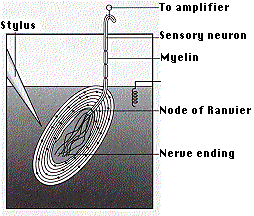| Index to this page |
| These last functions are carried out by the inner ear, which is discussed on a separate page. Link to it. The other functions are discussed here. |
Light touch is detected by receptors in the skin. These are often found close to a hair follicle so even if the skin is not touched directly, movement of the hair is detected.
In the mouse, light movement of a hair triggers a generator potential in mechanically-gated sodium channels in a neuron located next to the hair follicle. This potential opens voltage-gated sodium channels and if it reaches threshold, triggers an action potential in the neuron.
Touch receptors are not distributed evenly over the body. The fingertips and tongue may have as many as 100 per cm2; the back of the hand fewer than 10 per cm2.This can be demonstrated with the two-point threshold test. With a pair of dividers like those used in mechanical drawing, determine (in a blindfolded subject) the minimum separation of the points that produces two separate touch sensations. The ability to discriminate the two points is far better on the fingertips than on, say, the small of the back.
The density of touch receptors is also reflected in the amount of somatosensory cortex in the brain assigned to that region of the body.| Link to illustrated discussion of the somatosensory cortex of the human brain. |

Because of its relatively large size, a single Pacinian corpuscle can be isolated and its properties studied. Mechanical pressure of varying strength and frequency is applied to the corpuscle by the stylus. The electrical activity is detected by electrodes attached to the preparation.
Deforming the corpuscle creates a generator potential in the sensory neuron arising within it. This is a graded response: the greater the deformation, the greater the generator potential. If the generator potential reaches threshold, a volley of action potentials (also called nerve impulses) are triggered at the first node of Ranvier of the sensory neuron.
Once threshold is reached, the magnitude of the stimulus is encoded in the frequency of impulses generated in the neuron. So the more massive or rapid the deformation of a single corpuscle, the higher the frequency of nerve impulses generated in its neuron.Adaptation occurs in most sense receptors. It is useful because it prevents the nervous system from being bombarded with information about insignificant matters like the touch and pressure of our clothing.
Stimuli represent changes in the environment. If there is no change, the sense receptors soon adapt. But note that if we quickly remove the pressure from an adapted Pacinian corpuscle, a fresh volley of impulses will be generated.
The speed of adaptation varies among different kinds of receptors. Receptors involved in proprioception - such as spindle fibers - adapt slowly if at all.
 The knee jerk is a stretch reflex. Your physician taps you just below the knee with a rubber-headed hammer. You respond with an involuntary kick of the lower leg.
The knee jerk is a stretch reflex. Your physician taps you just below the knee with a rubber-headed hammer. You respond with an involuntary kick of the lower leg.
| Welcome&Next Search |